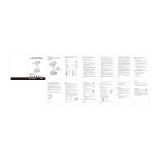
13
The following are PORTER-CABLE trademarks for one or more power tools and accessories: a
gray and black color scheme; a “four point star” design; and three contrasting/outlined longitudinal
stripes. The following are also trademarks for one or more PORTER-CABLE and Delta products:
Les éléments ci-dessous sont des marques de commerce des outils et des accessoires de
PORTER-CABLE : un agencement de couleurs grise et noire; un motif d’ « étoile à quatre
pointes » et trois bandes longitudinales contrastantes/à contours. Les marques suivantes sont
également des marques de commerce se rapportant à un ou plusieurs produits PORTER-
CABLE ou Delta : Las siguientes son marcas comerciales PORTER-CABLE que distinguen a
una o más herramientas y accesorios: un gráfico de color gris y negro; un diseño de “estrella
de cuatro puntas” y tres franjas longitudinales contrastantes/delineadas. Las siguientes también
son marcas comerciales para uno o más productos de PORTER-CABLE y Delta: 2 BY 4®,
890™, Air America®, AIRBOSS™, Auto-Set®, B.O.S.S.®, Bammer®, Biesemeyer®, Builders
Saw®, Charge Air®, Charge Air Pro®, CONTRACTOR SUPERDUTY®, Contractor’s Saw®,
Delta®, DELTA®, Delta Industrial®, DELTA MACHINERY & DESIGN™, Delta Shopmaster
and Design®, Delta X5®, Deltacraft®, DELTAGRAM®, Do It. Feel It.®, DUAL LASERLOC
AND DESIGN®, EASY AIR®, EASY AIR TO GO™, ENDURADIAMOND®, Ex-Cell®, Front
Bevel Lock®, Get Yours While the Sun Shines®, Grip to Fit®, GRIPVAC™, GTF®, HICKORY
WOODWORKING®, Homecraft®, HP FRAMER HIGH PRESSURE®, IMPACT SERIES™,
Innovation That Works®, Jet-Lock®, Job Boss®, Kickstand®, LASERLOC®, LONG-LASTING
WORK LIFE®, MAX FORCE™, MAX LIFE®, Micro-Set®, Midi-Lathe®, Monsoon®, MONSTER-
CARBIDE™, Network®, OLDHAM®, Omnijig®, PC EDGE®, Performance Crew™, Performance
Gear®, Pocket Cutter®, Porta-Band®, Porta-Plane®, PORTER-CABLE®, PORTER-
CABLE Professional Power Tools®, Powerback®, POZI-STOP™, Pressure Wave®, PRO
4000®, Proair®, Quicksand and Design®, Quickset II®, QUIET DRIVE TECHNOLOGY™,
QUIET DRIVE TECHNOLOGY AND DESIGN™, Quik-Change®, QUIK-TILT®, RAPID-
RELEASE™, RAZOR®, Redefining Performance®, Riptide®, Safe Guard II®, Sand Trap
and Design®, Sanding Center®, Saw Boss®, Shop Boss®, Sidekick®, Site Boss®, Speed-
Bloc®, Speedmatic®, Stair Ease®, Steel Driver Series®, SUPERDUTY®, T4 & DESIGN®,
THE AMERICAN WOODSHOP®, THE PROFESSIONAL EDGE®, Thin-Line®, Tiger Saw®,
TIGERCLAW®, TIGERCLAW AND DESIGN®, Torq-Buster®, TRU-MATCH®, T-Square®,
Twinlaser®, Unifence®, Uniguard®, UNIRIP®, UNISAW®, UNITED STATES SAW®, Veri-Set®,
Versa-Feeder®, VIPER®, VT™, VT RAZOR™, Water Driver®, WATER VROOM®, Waveform®,
Whisper Series®, X5®, YOUR ACHIEVEMENT. OUR TOOLS.®
Trademarks noted with ® are registered in the United States Patent and Trademark Office
and may also be registered in other countries. Other trademarks may apply. Les marques
de commerce suivies du symbole ® sont enregistrées auprès du United States Patent and
Trademark Office et peuvent être enregistrées dans d’autres pays. D’autres marques de
commerce peuvent également être applicables. Las marcas comerciales con el símbolo ® están
registradas en la Oficina de patentes y marcas comerciales de Estados Unidos (United States
Patent and Trademark Office), y también pueden estar registradas en otros países. Posiblemente
se apliquen otras marcas comerciales registradas.
4825 Highway 45
North Jackson, TN 38305
(888) 848-5175
www.portercable.com















